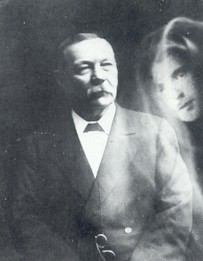The patron of our Spiritist Society is the Scottish writer and physician Sir Arthur Ignatius Conan Doyle (Edinburgh, May 22, 1859 – Crowborough, July 7, 1930), who was most noted for his stories about the detective Sherlock Holmes, generally considered a major innovation in the field of crime fiction.

A Spirit Photograph that Sir Arthur posed for that purports to have the spirit of his son, Kingsley, who was killed in the Great War
But beyond success as a prolific writer of crime fiction, Conan Doyle was a contemporary of Allan Kardec and a great enthusiast and champion of the Spiritism, a movement that, in his own words in the preface of his 1926’s book ‘The History of Spiritualism’, was regarded “as the most important in the history of the world since the Christ episode”. Doyles spiritualist writings also include The Wanderings of a Spiritualist (1921) and Pheneas Speaks: Direct Spirit Communications in the Family Circle (1927).
He is Honorary President of the International Spiritualist Federation, was President of the London Spiritualist Alliance (afterwards the College of Psychic Studies), and President of the British College of Psychic Science.
Below is a biography of Doyle, taken from Survival After Death.
Arthur Conan Doyle
FAMOUS BRITISH writer and creator of ‘Sherlock Holmes’. President of the College of Psychic Studies, Federation Spirite Internationale and the London Spiritualist Alliance.
By twenty years old and in his third year of medical studies, Doyle was offered the post of ship’s surgeon on the Hope, a whaling boat, about to leave for the Arctic Circle. In 1881 he obtained his Bachelor of Medicine and Master of Surgery degree. Doyle’s first gainful employment after his graduation was as a medical officer on the steamer Mayuba.
In March 1886, he started writing the novel which catapulted him to fame. At first it was named A Tangled Skein and the two main characters were called Sheridan Hope and Ormond Sacker.
His first introduction to supernormal phenomena took place while he was yet a physician at Southsea. In the years between 1885-88 he was invited to take part in table-turning experiments at the house of a patient, General Drayson, a teacher in the Greenwich Naval College, a keen mathematician and a man of scholarly education. He later joined the SPR and carried out a series of experiments with a Mrs. Ball and satisfied himself that telepathy was a fact. As regards survival, in 1902 when he first met Sir Oliver Lodge he had not arrived at a definite conclusion. But Myers’ Human Personality made a deep impression on his mind. His wife, a levelheaded woman, came to share Doyle’s interest in psychical research and survival, and actually developed the ability of “trance-writing.”
Source (with modifications): An Encyclopaedia of Psychic Science by Nandor Fodor (1934).
Also read online The Vital Message, one of Doyle’s most read books, containing a wealth of information relating to survival research, its prominent figures and how this ground-breaking research affects religion.
